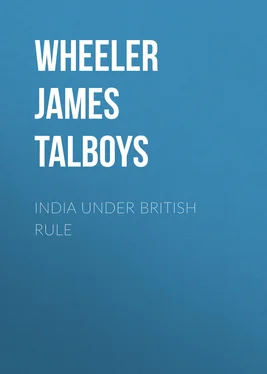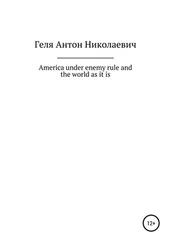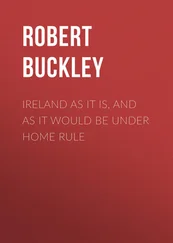Restricted authority of Lord Clive.
§5. The change from Lord Clive to Warren Hastings was most momentous. Lord Clive was a soldier born to command. Warren Hastings was emphatically an administrator born to rule. From the first Lord Clive had shirked all political responsibility. He was content to place the East India Company in the position of Dewan, with the additional duty of maintaining a standing army for the defence of the country, but without attempting to invest it with the ruling powers of a Nawab. So long as the Company took over the revenue, the Nawab and his officials were left to govern the people, and administer law and justice, according to their own will and pleasure. For himself, Lord Clive was content to rule the Company's settlement and some small cessions of territory of no account, and to leave the outside masses in utter darkness.
Vast dominion of Hastings.
Warren Hastings went to Calcutta as absolute ruler over the three provinces. He was a prince amongst princes; the equal if not the superior of any Hindu or Mohammedan ruler within the Himalayas and the two seas. As President of the Council his authority was not confined by the Mahratta ditch, but stretched far away over territories as large, if not larger, than Great Britain and Ireland. He united the powers of British Governor, Nawab, and Great Mogul. He was destined to strip the Nawab of every vestige of authority; to cut down his yearly income from half a million sterling to 160,000 l ., and to reduce him to the condition of a private Mohammedan grandee dwelling at Murshedabad. As for the Great Mogul, he had vanished from the scene. In 1771 he had quitted Oudh and returned to Delhi with the Mahrattas, and thereby forfeited his pension and empty suzerainty as far as the British were concerned. Later on, the Mahrattas demanded payment of the yearly tribute, but were flatly refused by Warren Hastings.
Career of Hastings ante 1772.
In 1772 Warren Hastings was forty years of age, with very large experiences. He had landed at Calcutta at the age of eighteen, and served as a clerk and warehouseman in the factory at Calcutta. In 1757, after the battle of Plassy, he was Resident at the court of Nawab Mir Jafir at Murshedabad. Later on, during the quarrel with Mir Kasim, he was a member of the Council at Calcutta, and one of the very few who took the part of the Nawab. In 1764 he went to England and became poor. In 1769 he returned to India and was appointed member of the Council at Madras. In 1772 he proceeded to Calcutta to become Governor of Bengal, Behar, and Orissa, in other words—to govern territories covering an area of 150,000 square miles, or one-tenth of the great continent of India. Henceforth his dominion extended from the mouths of the Ganges to the foot of the Himalayas, and from the frontier at Oudh to the frontiers at Assam and Bhutan.
Two portraits.
Warren Hastings must be regarded in two different aspects. In 1766, whilst residing in England, his portrait was painted by Sir Joshua Reynolds, and represents a mild, benevolent, and intelligent English gentleman. Twenty years afterwards another portrait was painted, which represents a stubborn and vindictive official, from whom all traces of the mild gentleman had disappeared. 9 9 The first portrait of Warren Hastings was exhibited at the Grosvenor Gallery in 1883. The second portrait is still hanging in the Council Chamber at the India Office at Westminster.
British rule in Bengal provinces.
§6. The first task of Warren Hastings was to introduce British administration into the Bengal provinces. The work had been easy enough when dealing with the population of towns, who were dependent on the East India Company for employment and protection. But dealing with provinces having a population of twenty or thirty millions of Hindus and Mohammedans, who knew very little of the British, and very little of their laws or ways, was a very different matter, and demanded extreme tact and caution.
Land revenue.
Warren Hastings began the work of government with the reform of the land revenue—the backbone of all administration in India. In those days the task was beyond the strength of any Englishman or body of Englishmen. During the Mahratta invasions and sudden changes of Nawabs the collection of the revenue had fallen into utter confusion, and it was impossible for Europeans to understand local rights or wrongs.
Zemindars and ryots.
The bulk of the land revenue in Bengal was collected by middle men, known as zemindars, from tenant farmers known as ryots. The zemindar was half a landlord and half a revenue collector. He generally possessed some hereditary land which was the family demesne; but outside the demesne were the landholders or ryots, from whom he collected the rents. The zemindar was not a landlord in the eyes of the ryots, because under Mogul law he could not raise the rents. Still he was a great man within his zemindary. He was magistrate, judge, and controller of the village police; and he had armed followers in his pay, who helped the village police in pursuing robbers and collecting rents. He had the right of hunting, fishing, and cutting wood, throughout his zemindary. Moreover, he levied irregular cesses, benevolences or aids, from the ryots, to defray the expenses of a birth or marriage within his own family, or to meet the demands of the Nawab in an emergency like a Mahratta invasion.
British zemindar at Calcutta.
The changes in the status of Bengal zemindars may be gathered from what is known of old Calcutta. Before the battle of Plassy the East India Company itself was nothing more than a Bengal zemindar, and held the settlement at Calcutta on a zemindary tenure. The Company was pledged to pay to the Nawab a fixed yearly royalty for their little territory. A British civil servant was appointed to represent the Company as zemindar, to bear the name and fulfil the duties of the post; and he collected the ground-rents within the Company's bounds and paid the yearly royalty to the Nawab. He could not raise the rents, for that was forbidden by Mogul law, but otherwise he was all powerful. He administered justice, criminal and civil, like the Justices of the Choultry at Madras. He also raised an additional income by farming out certain trades as monopolies, levying octroi duties on provisions, and taking fees for the registration of marriages, and sale of houses, boats, and slaves.
Auction sales of Calcutta lands.
After Plassy the British zemindar at Calcutta cared nothing for Mogul law. He raised the rents within the Company's bounds by the simple process of putting the leases up to auction; and the eagerness of the Bengalis to hold lands and sub-let them to under-tenants led to much competition and a large advance of rents. The zemindar who carried out this innovation was no other than Mr. Holwell, the same gentleman who was accepted as Governor of Calcutta on the morning of the day that ended in the Black Hole disaster. During that terrible night Mr. Holwell seems to have imbibed hatred and contempt for Moguls and Nawabs. Whilst Clive was shilly-shallying with Mir Jafir, Holwell was urging the deposition of the Nawab, the annexation of the Bengal provinces, and the radical measure of putting up all the zemindaries to public auction. 10 10 See Holwell's Historical Events in Bengal .
This scheme was ignored at the time as the dream of a madman; but nevertheless, within fifteen years, or half a generation, it was seriously considered by Warren Hastings.
Mogul revenue records.
Mysterious disappearance.
The revenue records of the Moguls had always been singularly complete down to the minutest detail. The holding of every ryot and the area of every zemindary had been measured and remeasured; the average value of the yearly produce of every field had been calculated; and the yearly rents payable by the ryots and the yearly revenue payable by the zemindar had been fixed in each case on the basis of the average harvests. All these details had been entered at length in the Mogul records. But the revenue records which contained all the details respecting the land in the Bengal provinces had mysteriously disappeared when they were most wanted. A Mohammedan contemporary says that they were all destroyed when Mir Kasim fled into Oudh. Possibly they may have been thrown into the Ganges and carried out to sea.
Читать дальше












